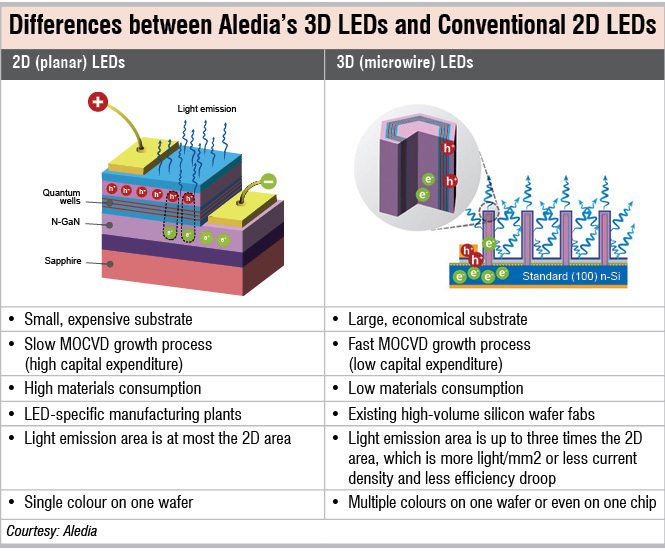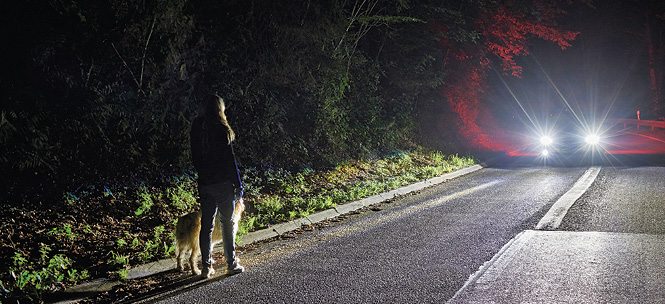Lighting has come a long way, from flint stones and firewood to fluorescent lamps and now light emitting diodes (LEDs). Today, we continue to see innumerable developments in this segment, right from space and power saving to smartness and smart uses (to make other objects smart). As we draw to the end of the year, which the United Nations designated as International Year of Light and Light Based Technologies (www.light2015.org/Home), let us take a look at some such technologies and products.

Light for the new-age farmer
Royal Philips, a company that has been into horticultural lighting for several years now, has recently opened GrowWise City Farming Research Centre in the Netherlands for developing tailor-made LED light growth recipes that will help farmers to grow tasty, high-yielding crops indoors, all round the year. Their research will first focus on leafy vegetables, strawberries and herbs, and later branch out to find ways to grow more carbohydrate-rich crops like wheat and potatoes indoors.
The large facility is a clean and sterile environment that completely blocks off natural light and air to exercise full control over the growing conditions. It has four-layered mechanised planting racks in each of its eight climate rooms, which makes a total growing surface of 234sqm. Each plantation layer is equipped with connected, fully-customisable LEDs, including blue, red and far-red LEDs that are designed and formulated specifically for growing crops. Since LEDs are highly energy-efficient and produce less heat, these are much cooler and can be placed closer to the plants and positioned optimally for uniform illumination.
This research of Philips is very crucial for future sustainability as more and more farming land is being engulfed by the expanding cities. Growing food indoors at optimal conditions with minimal effort and resources, and the ability to grow foods closer to home, will encourage more people to take up farming, too.
Controlling the functioning of humans
One of the key focus areas of this year’s Strategies in Light Conference held at Las Vegas, USA, was human-centric lighting projects, designed to optimise or improve some aspects of human behaviour. Extensive research is being done around the world on how a human body responds to light exposure and how this can be used to improve the mental or physical state of a person.
The Seattle Mariners’ stadium, a major league baseball stadium in Seattle, USA, for example, has fitted the home team locker room with new solid-state lighting that has features to tweak the players’ circadian rhythm for optimum alertness. One of the speakers has described methods for integrating sensors into lighting systems to produce light optimised for a given activity. The non-invasive sensors automatically categorise occupants’ activities and adjust the lights for performance improvement—of the person, not just the light!
Philips SchoolVision is a similar solution that helps students to focus on their work, facilitates teachers to teach better and also results in energy savings for the school. According to the time of the day and activity planned, teachers can choose between four modes that mimic the natural patterns of daylight that humans respond to. During a test, for example, Focus mode sets the light intensity to highest and the colour tone to cool, supporting focus and concentration. To calm a chattering class, Calm mode sets a standard intensity level with a warm colour tone. Other modes include normal classes and energetic sessions.
Elsewhere in the world, National Science Foundation, USA, has funded a research by Brown University, Rhode Island, USA, to develop lighting systems that will influence kids’ natural circadian rhythms of sleeping and waking, so they can adjust to early morning classes in school. This can also help adults, especially those recovering from health problems, to sleep better.
Mimicking sunlight
CoeLux, recently nominated by World Economic Forum as one of the Technology Pioneers 2015, has invented an artificial skylight that can light up a room’s ceiling as if it were lit up by sunlight. Variants of the lighting system mimic the way sunlight appears at three different latitudes on Earth. It does this using special nano-structured materials that scatter light from the LEDs, just as tiny atmospheric particles scatter sunlight—a phenomenon known as Rayleigh’s scattering.
This project is funded by the European Commission, as it promises to improve the quality of life indoors, in offices, hospitals and many other closed spaces. An organisation called Humanitas, for example, has installed CoeLux’s sun-like lighting in its radio surgery department. In contrast to the darkness maintained in radio surgery bunkers to protect technicians against radiation, the cheery sunlight tends to immediately perk up patients’ moods, alleviating their stress and helping them respond better to treatments.
Smartcars have smartlights
Smart lighting featured in automobiles are helping improve safety and driving comfort. One example is the new lighting system being developed by Ford. The technology combines effective spotlighting with infrared (IR) cameras to draw the driver’s attention to potential hazards on the way.
At a time, the IR camera can detect up to eight pedestrians, cyclists or animals on the way. An in-car screen displays the image captured by the camera, highlighting the detected objects in yellow and marking the two riskiest ones in red. The smart spotlighting system also cranks into action immediately. Moveable spotlights beneath the headlights illuminate the people or animals detected by the IR camera, casting a line along the road to make them more visible.
The same system can also be used to keep an eye on road signs, to adjust and widen the headlight beam at road junctions and roundabouts to help drivers navigate easily.

Leading the pack of smartdevices
When we speak of smart lighting, the first thing that comes to mind is connected, controllable light accessible through apps. However, light is also an enabler of smartness in other devices. One example of such a system is LiSense, developed recently by researchers at Dartmouth College, USA.
LiSense is basically a system that enables the lights in your room to recognise you and your movements, and also to autonomously control other devices to make you feel comfortable. For example, as soon as you come into your home, slump onto the couch and wave your hand, light in the living room instructs the air-conditioner to turn on and your coffee maker to start brewing.
The team uses an advanced shadow based sensing system to recognise the user’s presence and gestures, and harnesses developments in visible light communications for transmitting instructions to other devices. Basically, information gets encoded as light intensity changes at high frequency, and since most current-generation smartdevices have light sensors, these are able to receive data by monitoring the changes in light. This happens very subtly and is not visible to the human eye.
According to Xia Zhou, lead author of a paper on the research, the team wants to use smartlights to turn every indoor space into a cognitive space. In the future, they hope to make the system capable of handling more than low-level gestures to monitor the occupants’ behaviour, observe changes and may be even detect diseases.
Making cities safe, eco-friendly
According to a recent Navigant Research report, 40 per cent of a city’s power usage can be attributed to street lighting. While this is one of the biggest reasons compelling corporations to retrofit streetlights with LEDs, the ability to make these lights smart is also working in their favour. Smart street-lighting systems offer dashboards that provide a bird’s eye-view of the whole city’s lighting system as well as the ability to control it. These systems also offer various ways to save power by, say, switching off and on at programmed times.
One step ahead is Philips LumiMotion lamp-post that combines a streetlight with a motion sensor to automatically switch on when someone approaches. Such smartsystems can be combined with navigational headsets for visually-impaired people to help them understand their environment in various ways, say, by reconstructing their surroundings in sound or haptic formats. This makes smart streetlights cost-effective, controllable and socially-friendly, and saves energy, too.
This means that the use of LED lights for street lighting does not end with retrofitting. Countries have to research and completely understand their potential to ensure that these benefit the society, too.
Denmark, for example, has undertaken a study at Danish Outdoor Lighting Lab, or DOLL, an industrial park outside Copenhagen, Denmark, with 9km of road and bike paths fitted with smart lighting systems from 18 companies. They are investigating options like controlling the system using iPads, making lights brighten when a vehicle or pedestrian approaches, managing parking and transmitting information about traffic, weather or air quality.

Adding a dimension to LEDs
All this smart lighting requires a lot of LEDs. The cost at which lights sell today makes it seem impossible to fit the whole world with it. So while probing a bit into the core tech, we stumbled upon a four-year-old French company called Aledia that develops low-cost LEDs with a unique three-dimensional (3D) architecture. Their special WireLED microwire technology enables the manufacture of LEDs at 25 per cent the cost of current technologies by growing high-density, coaxial gallium-nitride (GaN) microwires directly onto large-diameter silicon wafers. This can be done using existing complementary metal-oxide semiconductor (CMOS) foundries.
Aledia’s technology uses economical silicon wafers with large diameters of 20cm or more and millions of vertical GaN microwires, or microrods with a diameter of less than one micron are grown on each wafer. Each of these microwires is an LED capable of emitting light from all sides. Use of large substrates significantly brings down the cost of each 3D LED, compared to today’s planar ones.
Moreover, this process also involves lesser time. The advantage of being able to manufacture and package the LEDs in existing CMOS facilities does away with large capital investments, making the new technology all the more attractive.
Cost aside, WireLED chips are also believed to be technically superior because these are designed to contain microwires that emit light over a broad range of different wavelengths, making it possible to produce green or red LEDs using the same material as industry-standard blue GaN LEDs. By combining different microwires on the same chip, white LEDs can also be manufactured without using phosphors.
Lighting without electricity
With the amount of research and development happening across the world, it is clear that smartlights are the future, be it at home, in industries or public places.
Much into the future, lighting might get even smarter—with priorities moving away from smartness and control to simply saving our planet. Dutch designer Daan Roosegaarde, for example, has come up with a completely off-beat approach to public lighting. Learning from bioluminescence in natural systems, he has found a way to light up a smart highway in the Netherlands using glow-in-the-dark paint as road markings. The special paint absorbs sunlight during the day to glow in the dark at night. In collaboration with State University of New York, USA, he has also developed a prototype plant containing luciferin, the compound that produces light in creatures like fireflies and jellyfish.
With his team, he is now working on developing bioluminescent street trees that will produce a soft-green glow in the dark. When streetlights are replaced with these trees, these will not only work without electricity—a fact too good to be true—but also make the highway look like a scene out of a fairy tale!






